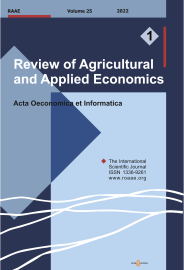KEYWORDS:
consumer demand; Kenya; LA/AIDS; vegetable consumption
DOI NUMBER:
10.15414/raae.2022.25.01.94-103
ABSTRACT:
Research background: Vegetables are important sources of nutrition to many households. Understanding the household demand system of leafy African indigenous vegetables (AIVs) in Kenya could enhance designing strategies to increase their consumption levels.Purpose of the article: The study was conducted to evaluate the effects of demographic variables on budget shares for commonly consumed leafy vegetables and to generate vegetable demand elasticities.
Methods: A stratified multi-stage sampling approach selected 168 and 282 respondents in rural and urban areas, respectively. The study used primary data, and a Linear Approximate Almost Ideal Demand System was estimated using the Seemingly Unrelated Regression method.
Findings, value & novelty: Own-price elasticities indicated that leafy AIV crops are normal goods. Cross-price elasticities indicated leafy AIVs are more complementary to each other and can be substituted for the consumption of exotic vegetables. The price effect could substantially contribute to changes in demand than would income. Vegetable demand could still increase with a future increase in household income. Expenditure elasticities classified cowpea (Vigna unguiculata L. Walp.) and spider plant (Cleome gynandra L.) as necessary vegetables. Results can be used to develop strategies for increasing demand for leafy AIV crops, thus enhancing consumption of healthy diets.
Please Cite this Article as:
Eric Obedy GIDO (2022) Household Demand System Of African Indigenous Vegetables In Kenya. Review of Agricultural and Applied Economics. XXV (Number 1, 2022): 94-103. doi: 10.15414/raae.2022.25.01.94-103
URL for sharing:
https://roaae.org/1336-9261/doi/abs/10.15414/raae.2022.25.01.94-103
FULL TEXT PDF:
▼ direct download link| view online in fullscreen ▲
References:
▼ direct download link

